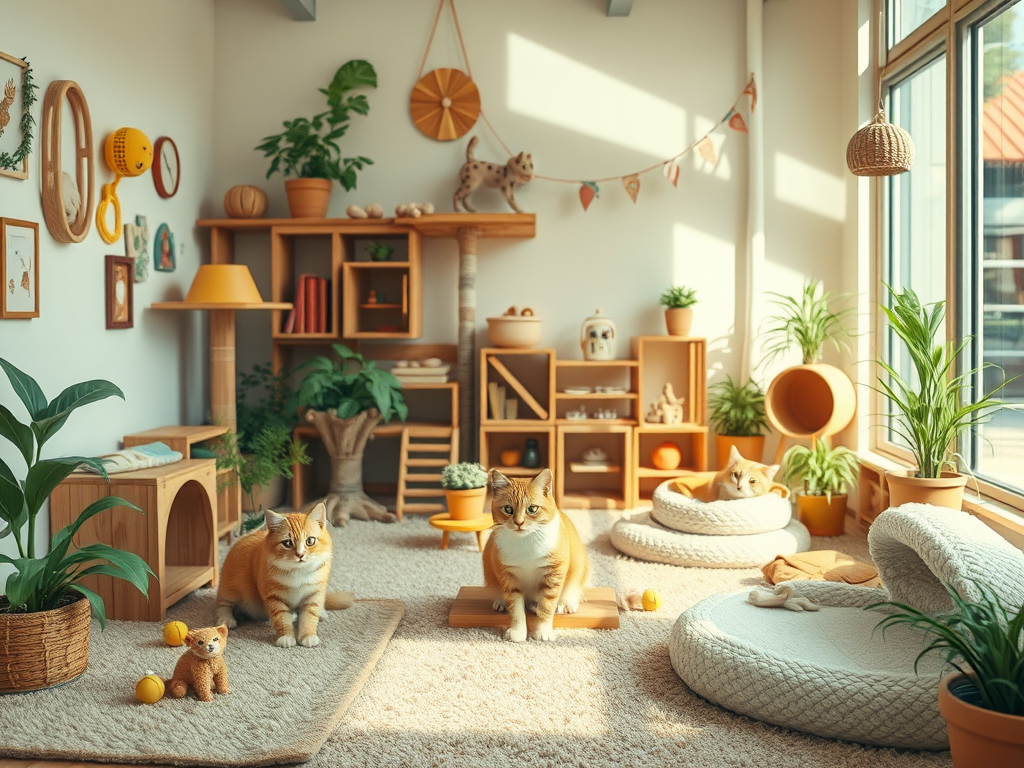Effective Strategies for Reducing Your Cat’s Hunting Behavior
Reducing the Impact of Your Cat’s Hunting Instincts: Cats are born hunters, a trait deeply embedded in their genetics, shaped by their wild ancestors. To foster this natural behavior while safeguarding local wildlife, it’s crucial to create a safe indoor environment that stimulates their instincts. By designing interactive spaces and engaging activities, you can keep your feline companion mentally and physically active, ensuring they find joy and fulfillment indoors without posing a risk to outdoor creatures.
Incorporating interactive toys into your cat’s playtime can greatly enhance their indoor hunting experience. Options like feather wands, laser pointers, and motorized mice provide endless entertainment and mimic the natural hunting behaviors of tracking and pouncing. These toys are not just recreational; they offer critical physical exercise and mental stimulation. By keeping your cat engaged with interactive play, you also promote their overall health and well-being, allowing them to expend energy constructively while having fun.
Transforming your home into a feline-friendly adventure zone is easier than you think. Create obstacle courses filled with tunnels, boxes, and platforms to encourage play and exploration. This setup functions as a mini jungle gym, providing opportunities for your cat to jump, climb, and explore. Cats are naturally curious, and by offering varied environments, you can satisfy their instincts, making them feel like they are on an exciting safari right in your living room.
Another effective tool in your arsenal is the puzzle feeder, an innovative device designed to challenge your cat both mentally and physically. These feeders mimic the effort required for hunting, keeping your cat engaged while they work for their treats. This method not only entertains but also promotes healthy eating habits, allowing your cat to stay sharp and active. By integrating puzzle feeders into their routine, you can provide a fun and rewarding experience that channels their hunting instincts positively.
Prioritizing playtime is essential for nurturing your relationship with your cat. Engaging in social interaction through playtime is vital for building a strong bond. Set aside time for dedicated play sessions using their favorite toys. This shared activity alleviates frustration and enhances your connection, creating a fulfilling experience for both you and your feline friend. Regular playtime fosters trust and affection, making your cat happier and more secure in their environment.
With creativity and commitment, you can develop a stimulating indoor atmosphere for your feline companion. Your home can go beyond being a simple shelter, evolving into an engaging playground that satisfies their natural instincts while keeping them safe from outdoor dangers. Thoughtful planning and implementation can lead to a happy, well-adjusted indoor cat who thrives in their environment.

Harnessing the Benefits of Leash Training for Your Cat’s Outdoor Adventures
Introducing leash training can unlock a world of safe outdoor exploration for your cat. While walking is typically associated with dogs, many cats can also enjoy the great outdoors with the right training and patience. By acclimating your feline to a harness and leash, you can facilitate safe interactions with nature while keeping them secure and protected.
Start your leash training journey with a well-fitting harness that prioritizes comfort. Before attaching it, allow your cat to investigate the harness to minimize any anxiety. Familiarizing them with the harness through scent and sight can ease the process. Gradually introducing the harness at their pace fosters positive feelings and ensures a smoother transition when it’s time to wear it.
Once your cat is accustomed to the harness, attach a lightweight leash and practice walking indoors. This familiar setting will help them adjust to the new sensation of wearing a leash and build confidence. Take your time during this phase, and be prepared for some initial resistance. Patience is essential to acclimating your cat to this novel experience.
When it’s time to venture outside, choose a calm, secure area, such as your backyard or a quiet park. Opt for places with minimal traffic and distractions, allowing your cat to feel safe while exploring. Begin with short outdoor sessions to prevent overwhelming your pet, gradually extending the duration as they become increasingly comfortable with their surroundings.
Supervised outdoor time enriches your cat’s life by allowing them to enjoy the sights, sounds, and scents of nature without endangering local wildlife. Picture the delight on your cat’s face as they encounter new experiences in a secure environment. This bonding time enhances their quality of life and deepens your relationship, creating cherished moments together.
Real-life stories from fellow cat owners can inspire you. Many have shared their initial hesitations regarding leash training but discovered that consistency and positive reinforcement made all the difference. Celebrate each small victory as a step toward broadening your cat’s experiences while prioritizing their safety.
Incorporating leash training into your cat’s routine offers a blend of outdoor enjoyment and wildlife preservation. This balanced approach allows your cat to explore their environment while reinforcing a sense of security and safety.
Enhancing Your Cat’s Safety with Catios: The Perfect Outdoor Solution
Outdoor cat enclosures, commonly known as catios, offer a fantastic solution for adventurous cats yearning for outdoor experiences without the inherent risks. These secure spaces enable your feline friends to relish the outdoors while ensuring their safety and protecting local wildlife from potential harm.
Building or purchasing a catio can be customized to suit your space and budget. From simple balcony enclosures to elaborate backyard setups, the main focus should always be on creating an escape-proof structure that guarantees your cat’s safety while they enjoy their outdoor time.
When designing a catio, consider incorporating various levels and cozy hiding spots. Cats thrive in environments that provide vertical spaces and areas to retreat. Adding platforms, ramps, and hammocks transforms a basic enclosure into a stimulating paradise that mirrors their natural habitat, enhancing their overall well-being.
To further enrich the sensory experience within the catio, introduce elements such as cat grass, scratching posts, or logs. These additions create a stimulating environment filled with textures and scents, keeping your cat engaged and content while allowing them to savor the joys of being outdoors in a controlled setting.
Regular maintenance is essential to ensure your catio remains a safe haven. Routinely inspect the structure for signs of wear and tear, including the mesh integrity and lock functionality. Given their curious nature, cats may test the boundaries of their enclosure, making it vital to keep the catio in excellent condition for their safety and peace of mind.
With a catio, your feline friend can bask in the sun, climb, and observe wildlife from a secure vantage point, enjoying the great outdoors without posing a threat to local ecosystems. They can relish the sunshine and watch birds from their outdoor sanctuary, remaining content while nature is preserved.

Proven Behavioral Training Techniques to Mitigate Hunting Instincts
Training your cat to curtail hunting behaviors might appear daunting, yet it can be manageable with the right techniques. The first step is to understand the natural instincts that drive your cat to hunt, as this knowledge is critical for implementing effective training strategies.
Embracing technology can significantly enhance your training efforts. Consider utilizing motion-activated deterrents, like sprinklers or noise-makers, to create boundaries that discourage hunting behavior without disrupting their playtime. Strategically zoning your yard into safe areas can effectively redirect your cat’s attention away from potential prey.
Positive reinforcement plays a pivotal role in modifying your cat’s behavior. Reward them for exhibiting non-hunting actions with treats or affection. For example, if your cat responds to your call or refrains from chasing a potential target, shower them with praise or a tasty treat. This technique encourages them to repeat desirable behaviors while diminishing their instinctual urges to hunt.
Integrating clicker training can also be a powerful strategy. This method involves associating a distinct sound with positive actions, helping your cat understand the connection between their behavior and rewards. By clicking when they display desired behaviors, you can reinforce good habits and clarify expectations, leading to a more harmonious relationship.
For tailored support, consider consulting with feline behavior specialists. They can provide personalized advice and insights that address specific challenges, aiding you and your cat in coexisting peacefully while respecting local wildlife.
The objective of using deterrents and training isn’t to punish but to guide your cat toward behaviors that prioritize their safety and the environment. With consistency and patience, you can redirect their instincts, promoting safer outdoor interactions for both your cat and local wildlife.
Strategic Feeding Approaches to Alleviate Your Cat’s Hunting Drives
The type of food you provide and your feeding strategies can greatly affect your cat’s hunting instincts. Interestingly, even a well-fed cat might still exhibit hunting behavior; however, adjusting their feeding methods can help mitigate this urge.
Free feeding, which allows food to be available throughout the day, may not be suitable for every cat. Instead, consider establishing a structured feeding schedule. Predictable mealtimes can reduce the likelihood of hunting, as your cat learns to associate food with specific times, decreasing the need to seek out prey.
Implementing interactive feeding strategies can significantly transform your cat’s behavior. Utilizing food puzzles or dispensers can replicate hunting scenarios, requiring your cat to ‘work’ for their meals. This approach not only keeps them mentally engaged but also channels their energy positively, allowing their natural instincts to be expressed safely.
Attention to the nutritional content of their food is equally important. A diet high in protein and low in carbohydrates aligns better with a cat’s natural dietary needs, potentially leading to a decrease in hunting behaviors. Collaborating with a veterinarian can help tailor their diet to ensure all nutritional requirements are effectively met.
Finally, offering a variety of food types can satisfy their inherent curiosity and appetite for novelty. Rotating between dry kibble, wet food, and raw diets keeps mealtime interesting, reducing the temptation to seek excitement beyond their food dish.
Feeding strategies are not just about providing sustenance; they are a powerful tool for managing your cat’s behavior. By adjusting their diet and feeding methods, you can effectively reduce their inclination to hunt while keeping them satisfied and healthy.

Fostering Community Responsibility for Cat Conservation and Wildlife Protection
Cats are beloved companions, and as their guardians, we hold the responsibility to ensure they coexist peacefully with local wildlife. By embracing community initiatives and personal accountability, we can significantly lessen the ecological impact of free-roaming cats.
Engaging with local conservation groups is a fantastic way to stay informed on wildlife-friendly practices. Many communities offer educational workshops for cat owners, highlighting the ecological consequences of allowing cats to roam freely and presenting solutions to mitigate these impacts.
Consider initiating or participating in neighborhood discussions or online social media groups focused on responsible pet ownership. Sharing resources, experiences, and tips can cultivate a more wildlife-conscious community, creating a supportive network for all pet owners striving to protect the environment.
One proactive measure is to establish cat-friendly zones within community parks or gardens. These designated areas can feature enclosures or supervised play spaces, ensuring a safe environment for both cats and wildlife. Such collaborative efforts enhance awareness and foster positive interactions between pets and nature.
Incorporating family-friendly initiatives, such as sticker campaigns or educational contests for children and teens, can help raise awareness about responsible pet ownership and the importance of coexisting with wildlife.
Lead by example at home by implementing the strategies you’ve learned. Whether it’s leash training, building catios, or modifying feeding practices, showcasing your dedication to a harmonious relationship between your cat and the environment can inspire others to follow suit.
By combining individual actions with community-based initiatives, we can create a supportive network that balances our cats’ needs while promoting ecological stewardship. Together, we can celebrate our pets while respecting and protecting the natural world around us.
The Article: Minimize Your Cat’s Hunting Impact Appeared First On Unity Pets.
The Article Minimize Hunting Impact of Your Cat Effectively Was Found On https://limitsofstrategy.com

